Ikunoshin Kadono: The Prodigy Known as Boy Teacher
Dubbed "Boy Teacher" by his peers and praised for his literary talent and mental acumen by Yukichi Fukuzawa himself, Ikunoshin Kadono took his first teaching position at the tender age of 15. We will trace the footprint he left on education at Keio and the Japanese insurance industry of the day.
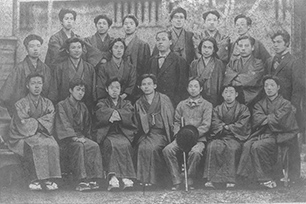
Individual in Western attire at center is Yukichi Fukuzawa.
Individual with long hair directly to his right is Kadono
Entered Keio at 13 years old and began teaching just two years later
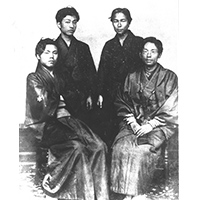
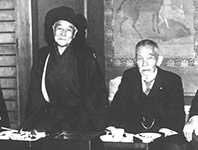
To the right is Prime Minister Tsuyoshi Inukai
Ikunoshin Kadono was born in the modern-day city of Toba, Mie Prefecture, on April 18, 1856, twelve years before the Meiji Restoration. His father, Toyoemon, was a samurai of the Toba Domain who seemed to have recognized the importance of Western learning early on. He began educating six-year-old Kadono on Western geography, the physical sciences, and the Dutch language. In 1869, the second year of the Meiji period, Kadono traveled to Tokyo to enter Keio as a Koshinsei, a scholarship student sponsored by his native Toba Domain. His academic abilities and scholarly diligence were unparalleled even at such a young age; in a mere two years, he began teaching fellow students as an English instructor, at the age of fifteen.
This is a quintessential example of the Keio spirit of hangaku hankyo, or "learning while teaching, teaching while learning," in which advanced students teach their juniors while continuing to learn for themselves. Even so, the ability to lecture to Japan's best and the brightest in his mid-teens is a testament to Kadono's exceptional genius. His talents, paired with his innocent boyish looks, earned him the nickname "Boy Teacher" among his older peers.
Fukuzawa himself placed confidence in Kadono, who became kyoto, or vice-principal, of Keio in 1883 at the age of twenty-seven after serving as head teacher. Admired as "Kadono the Bookworm" for his English reading comprehension, Kadono is esteemed among Keio students as one of the "Three Famous 'No' Teachers" alongside former Keio Presidents Kenzo Ashino and Sadashiro Hamano.
Another famous president in Keio history, Nobukichi Koizumi, was appointed as the jukucho, a position now known as president, in 1887 after resigning from the Ministry of Finance, when Kadono was serving as vice-principal. Under President Koizumi, drastic reforms were made to the examination system to be carried out the following year. Among the reforms was a system devised by Kadono to trade Keio's conventional evaluation methods, which entailed a teacher's personal assessment or consensus among several teachers, for a rigorous point system. However, his plans for reform would cause widespread controversy. Students objected that such a system was better left for state schools and was incompatible with the educational ethos of Keio. This backlash led to a student-led boycott of classes by around 280 students. The strike was finally quelled after about a month when Fukuzawa stepped in to persuade the students to return to classes.
Although met with hostility among some students, Kadono's proposals were a precursor to the establishment of a modern university, a movement which had been gaining momentum at the time. He went on to play an integral part as part of the University Establishment Committee in 1889, contributing a great deal to Keio's inauguration as a university in the following year of 1890 by proposing the establishment of the departments of literature, law, and economics.
Holds key positions such as trustee and fuku-shato
Pioneers the Japanese insurance industry with the founding of Chiyoda Life Insurance
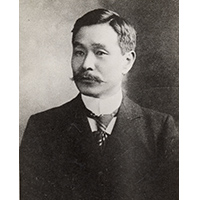
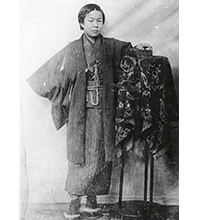
In April 1898, at a juncture when Keio was seeking to make academic improvements to its university structure, Kadono was sent abroad to observe the situation of education in the West. The reforms he brought back to Japan the next year were revolutionary and included abolishing the three departments in favor of a single department that would comprise of certain compulsory subjects but also give students the autonomy to take subjects of their own choosing.
This system was implemented in the first term of 1900 but failed to garner understanding within Keio itself or from society at large, perhaps due in part to its hasty implementation; the university ended up reverting to its former three-department structure the following year. Though his system may have faltered, Kadono's ambitious attempts reveal a zealous passion for education.
In 1901 after the passing of Fukuzawa, Kadono was appointed fuku-shato, a supporting role to the shato, the highest-ranking position in the administration of Keio and a position which Yukichi Fukuzawa held until his death. The next year he resigned from his post as vice-principal and retreated from the front lines of education in a transition into business, but kept his post as fuku-shato until 1907. Following this, he long served as a trustee and councillor of Keio. Additionally, in periods of a Keio president's absence, such as after President Eikichi Kamata's appointment as Minister of Education (1922) and during President Shinzo Koizumi's travels to the United States (1936), he would serve as president of administrative matters on their behalf. This attests to Kadono's position as a highly-esteemed senior member of the Keio community.
Kadono's business endeavors began with establishment of Chiyoda Mutual Life Insurance in 1904, where he served as president. He then founded Daiichi Kikan Kikan Insurance, Nippon Conscription Insurance, Chiyoda Fire Insurance, and Chitose Fire and Marine Insurance in rapid succession. Moreover, he took charge as chairman of Jiji Shimpo in 1928 at a time when it faced great difficulties, reviving the newspaper at his own personal expense.
Kadono passed away at the age of 82 on November 18, 1938, as one of the oldest and most revered members of the Keio community and a distinguished trailblazer in the insurance industry, which Fukuzawa had introduced to Japan only years before. After entering Keio at thirteen and becoming the "Boy Teacher" at fifteen, he dedicated nearly 70 years of his life to Keio and its pursuit of academic excellence.
Brief Timeline of Events in Ikunoshin Kadono’s Life
| Year | Age | Event |
|---|---|---|
| 1856 | 0 | Born in present-day city of Toba, Mie Prefecture |
| 1869 | 13 | Enters Keio as a Koshinsei sponsored by his native Toba Domain |
| 1871 | 15 | Becomes a teacher at Keio |
| 1883 | 27 | Becomes kyoto, or vice-principal, of Keio |
| 1888 | 32 | Student-led boycott of classes due to reforms |
| 1889 | 33 | Dedicates himself to the establishment of a university as a member of the University Establishment Committee |
| 1890 | Keio University established | |
| 1898 | 42 | Departs for a tour to observe Western educational systems |
| 1899 | 43 | Returns to Japan Outset of his reforms to the university educational system |
| 1901 | Yukichi Fukuzawa passes away | |
| 1901 | 45 | Appointed as Fuku-shato |
| 1902 | 46 | Resigns from his position as vice-principal Transitions into the business world |
| 1904 | 48 | Establishes Chiyoda Life Insurance and serves as president |
| 1907 | 51 | Resigns from the position of Fuku-shato |
| 1928 | 72 | Appointed as chairman of Jiji Shimpo |
| 1932 | 76 | Receives Imperial Commission to be a member of the House of Peers |
| 1938 | 82 | Passes away |
*Photos courtesy of Fukuzawa Memorial Center for Modern Japanese Studies.
